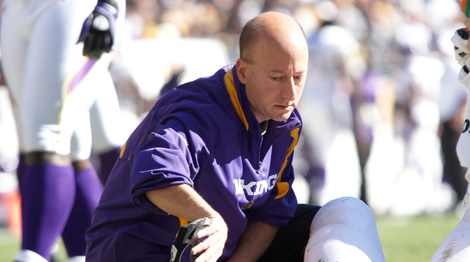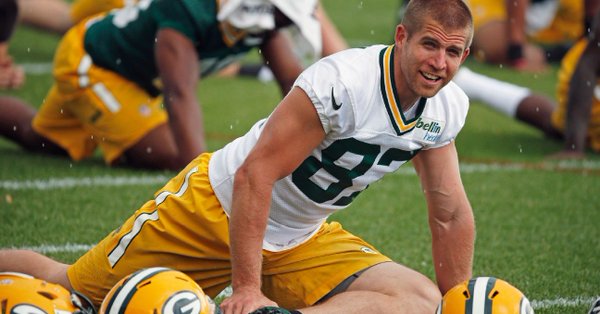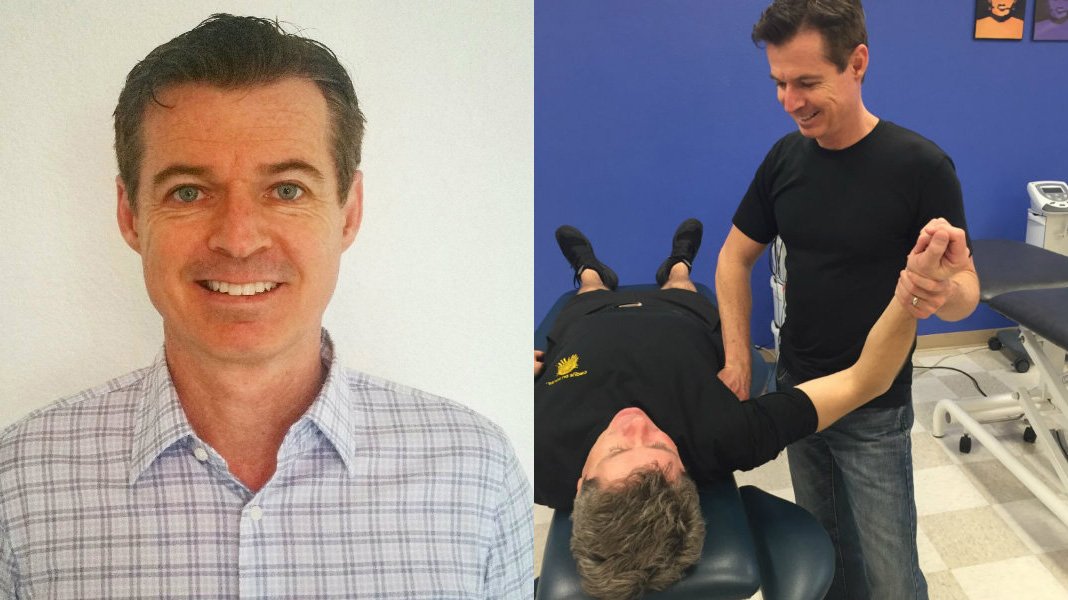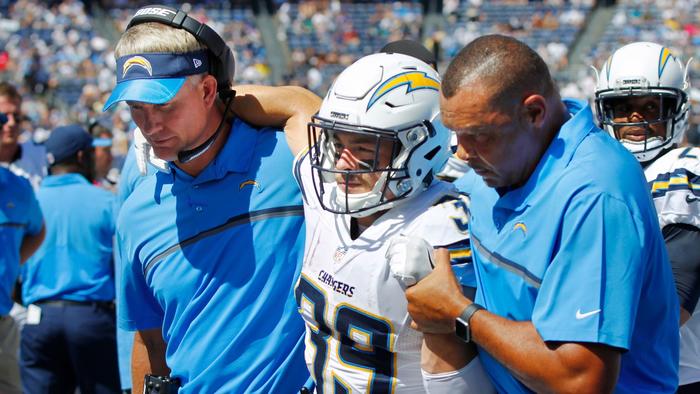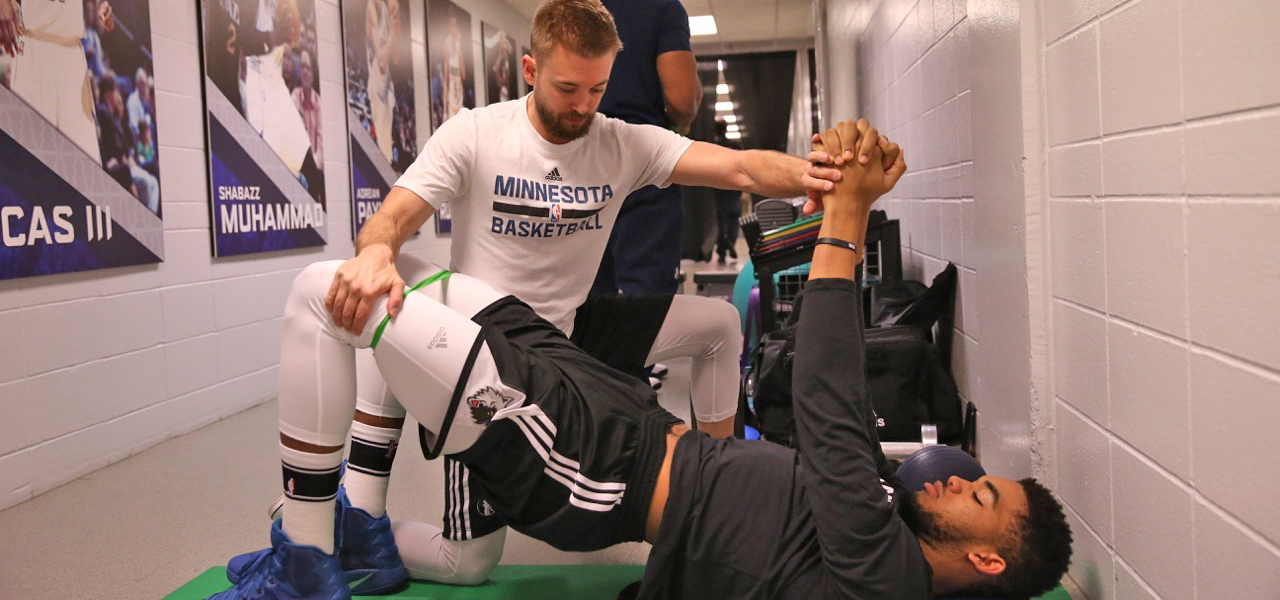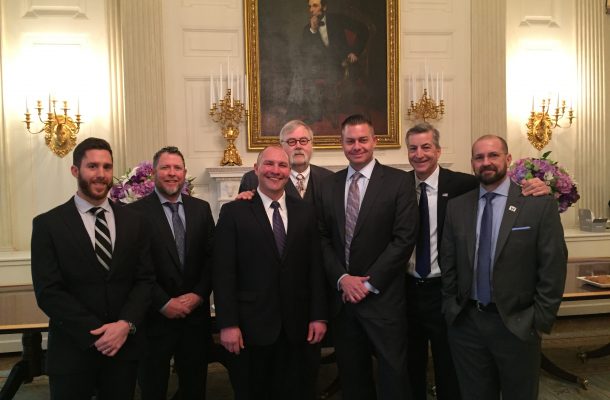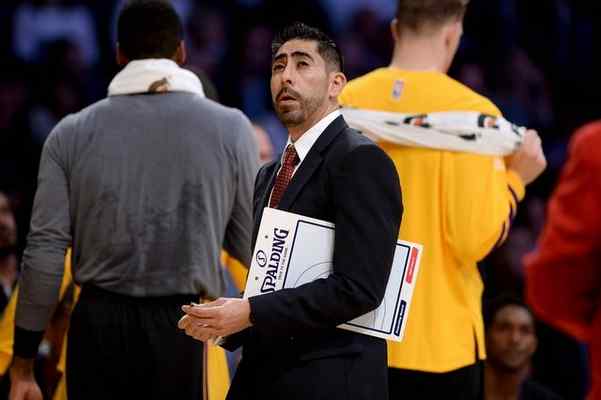
Article reposted from San Gabriel Valley Tribune
Author: Mark Medina
As Marco Nuñez plopped into a booth in a Miami restaurant, it marked his first spare moment after grabbing 3-1/2 hours of sleep.
The previous night in Charlotte, Nuñez, in his first season as the Lakers head athletic trainer, treated Larry Nance Jr. after the reserve forward injured his left knee. Soon after, Nuñez scheduled Nance’s MRI for the next day before joining the team for the flight to Miami. Nuñez arrived late to the airport (1:30 a.m.), the hotel (3:30 a.m.) and his bed (4:30 a.m.).
Nuñez then woke up at 8 a.m. to finalize Nance’s MRI visit, secure a bus for practice and treat other players. Nuñez stayed busy after practice, taking Nance to his MRI appointment, awaiting the results and consulting with doctors. Nuñez then informed Nance, his agent and the Lakers about the bone bruise in Nance’s left knee that would sideline him for four weeks. Around 9 p.m., Nuñez finally ate dinner.
This schedule during a trip in late December captured Nuñez’s typical workload in that entails both treating injured players and handling logistics with the team’s travel. As the Lakers near the end of the 2016-17 season, Nuñez has grown accustomed to juggling various responsibilities during his first season as the Lakers’ head athletic trainer.
There have been a lot of days like this for Nuñez, in his first season in this role.
“I don’t know if I’ve had time to sit down and say what I like or don’t like,” Nuñez said. “I have hit the ground running. I’m just glad to keep going.”
Nuñez, who joked that he would have preferred sleeping in before practice then enjoying the beach, has refused to relax, though. To prepare for his “dream job,” Nuñez shortened his August vacation from two weeks to three days.
“About 30 years from now, I might regret doing that,” Nuñez said. “But at the moment, it felt like it was the right thing to do.”
When he joined the Lakers’ training staff for the 2008-09 season, Nunez wanted to prove himself worthy of being the future successor to Gary Vitti, the Lakers’ longtime head athletic trainer. Nuñez also declined opportunities to go elsewhere, including when the Lakers laid off part of their training staff to save money during the 2011 lockout. After Nuñez received an offer from another NBA team, the Lakers retained him.
“I wanted to come back here,” Nuñez said. “This was my goal.”
So, Nuñez became what Vitti called his “right-hand guy.” Vitti groomed and recommended him to become his successor once he retired last season, capping a 32-year stint during which Vitti kept the Lakers’ multi-million dollar players healthy enough to win eight NBA championships in 12 Finals appearances while also handling all of the team’s travel arrangements.
The nature of that relationship has since changed.
Vitti has remained under contract as an athletic training consultant. But since the Lakers fired longtime general manager Mitch Kupchak and executive Jim Buss on Feb. 21, Vitti has not been at any practices or home games. Vitti declined to comment about his lack of attendance and referred questions to the Lakers.
Team spokesperson Alison Bogli said Vitti remains welcome at games and at the facility. Bogli added that Lakers GM Rob Pelinka is evaluating Vitti’s role in various technology projects. Those have included talking with software engineers and analytics firms, meeting with vendors about wearable sensors and sneaker microchips, examining SportVU data and exploring trends in sports medicine and nutrition.
“I worked more than half of my life with the Lakers and look in the mirror and feel good about what I have given them,” Vitti said. “I gave them everything I had every single day. I will forever be grateful to (the late Lakers owner) Dr. (Jerry) Buss, a man I believe exemplified the most important human values in honesty, kindness and loyalty. It’s Jeanie (Buss’) team. It’s not my team. There’s nothing I can do. She’ll do what is best for the team.”
As for Nuñez, Vitti said, “He hasn’t had a shortage of stuff to deal with. He’s had a lot for a first-year guy. He’s gotten slammed. I don’t think he’s come up for air yet.”
EARNING TRUST
Vitti’s retirement party at Petros in Manhattan Beach last April showed Nuñez something as valuable as when he watched Vitti heal players.
Lakers luminaries expressed their affection for Vitti. Magic Johnson, Jerry West, Kareem Abdul-Jabbar, James Worthy, Byron Scott, Derek Fisher, A.C. Green and Mitch Kupchak were all in attendance, and that had more to do with the bond Vitti forged than it did with healing their wounds.
“That’s when it hit me,” Nuñez said. “I can be a great trainer. I can rehab a guy. I can treat a guy. I can tape a guy. But if I don’t have that trust or relationship with these players, this whole thing doesn’t really work.”
That played out in different ways for Vitti as a “contemporary” during the Showtime Era and a “father figure” in later decades.
Vitti and Johnson bonded over their charming personalities. Vitti then became one of Johnson’s confidants when he tested positive for HIV. Vitti and former Lakers center Shaquille O’Neal used to “fight all the time” over his work habits. The tension diminished when O’Neal showed his playfuness. While marveling at Kobe Bryant’s determination to play through pain, Vitti often tried to protect Bryant from himself.
Through those circumstances, Vitti followed two rules. He told players, “I will never lie to you, but I will never lie for you.” He told the Lakers’ front office, “You’ll know what you need to know. But if you don’t need to know it, you’re not going to know it.”
“If you have a superstar on your team and he is the best person, it makes life a lot easier. But if your superstar makes life difficult, that’s tough,” Vitti said. “(Marco) hasn’t had that test yet. But when it comes his way, as uncomfortable as it is, you have to stand up for what you believe.”
Still, Vitti observed Nuñez already has cultivated “good, solid relationships with all the players.” First-year Lakers coach Luke Walton added Nuñez has done “a phenomenal job” in managing a roster that has dealt with its share of injuries.
“Everything about him is really professional,” said second-year guard D’Angelo Russell, who has dealt with injuries to both knees this season. “He takes his time and pays attention to everything. Everything was hands on. He didn’t need to pass me to an assistant.”
Nuñez has fulfilled that job description with a blend of sympathy and humor.
When the Lakers initially suspected veteran guard Nick Young strained his right Achilles tendon against New Orleans in late November, Nuñez comforted Young. Once an MRI revealed a strained calf that would sideline Young for a far shorter window (six games), Nuñez jokingly teased Young for exaggerating the pain.
“Gary likes to talk. He’s a big-time storyteller. Marco likes to crack jokes more,” Young said. “It’s been great. He knows the balance between keeping guys healthy and being funny.”
While helping Nance heal his left knee amid a minutes restriction, Nuñez also accommodated Nance’s request to keep after him about cold tub recovery when he returned to the court.
“There’s a few times I hate the cold tub. So I know if it’s up to me, I won’t do it,” Nance said. “I trust him to do that for me. He’s done a good job with it.”
When the Lakers spent three days in Charlotte in December, he encouraged Julius Randle to fly home to Los Angeles to support his fiancée, Kendra Shaw, who was expecting their first child, Kyden. Nuñez also arranged a flight for Randle later that week from Miami to Los Angeles to witness his son’s birth.
“He cares about us,” Randle said of Nuñez. “He did an amazing job taking care of me, my fiancée and my whole situation with my baby. He made sure everything was OK when I was on the road.”
A LONG JOURNEY
During his sophomore year at Cal Poly Pomona, Nuñez heard former head athletic trainer Ky Kugler deliver a keynote speech that emphasized what he called the “four P’s,” in preparation, poise, patience and perseverance. Once the speech ended, Nuñez introduced himself to Kugler and shared how that speech fueled his ambitions to become a head athletic trainer. Nuñez then changed majors from civil engineering to kinesiology.
“It sounds like (those qualities) defined Marco’s career. That was evident since I’ve known him,” Kugler said. “I thought he was always going to be successful.”
Nuñez carried out Kugler’s vision with a sports athletic training internship at Mount San Antonio Community College and Pasadena City College. He then had a short stint with the Long Beach Ice Dogs (1998), before taking on an assistant trainer role with the Los Angeles Avengers of the Arena Football League (1999-2002).
During that time, Nuñez saw several aspects of an industry where job security can be tenuous. After an Avengers player scolded him for taping his ankles poorly, Nuñez gathered friends as test subjects so he could perfect that job. Nuñez improved in his craft quickly enough that former Avengers head athletic trainer Brian Nguyen often deferred his workload to Nuñez.
As Nuñez’s responsibilities grew, he developed a more light-hearted relationship with players. He played pranks by pouring a bucket of ice water on players on their birthdays, and players nicknamed him “Blinkie” in reference to his constant eye twitching.
“It says something that is very endearing when people know your mannerisms like that,” Nguyen said, laughing. “Marco truly cares as an athletic trainer both with his job and working with people.”
That’s why Nguyen recruited Nuñez in 2003 for another project. After producers of the movie, “The Longest Yard,” hired Nguyen to treat actor Adam Sandler on set, Nguyen hired Nuñez to handle the rest of the cast, including the likes of former professional wrestler Steve Austin, rapper Nelly and former NFL player Michael Irvin.
While filming in Santa Fe, N.M., Nuñez’s most memorable experiences involved his time handling Irvin – an early test of his ability to handle star players nursing injuries.
After he tweaked his hamstring during a game of pickup basketball, Irvin asked Nuñez a pointed question.
“If I go out there, can I make it worse?” Irvin asked.
“Yeah, you could aggravate it,” Nuñez answered.
Irvin lightly slapped Nuñez s face. Irvin then repeated his question.
“If I go out there, can I make it worse?” Irvin asked.
“No,” Nuñez said. “You’ll be fine.”
After Nuñez treated Irvin’s hamstring, the Hall of Famer finished the scene without making his injury worse. In between laughs, Nunez said that anecdote isn’t about him caving to a demanding athlete.
“He knows his body,” Nuñez said of Irvin. “They know the risk.”
Soon after, the uncertainty of the industry cost Nuñez his job with the Avengers because Health South, his employer, experienced financial issues. Nunez landed another AFL job a short time later, but his time with the Carolina Cobras ended a year later for the same reasons.
“That was two years in a row where I felt I got screwed,” Nuñez said. “I got to a point where I thought there’s too much politics and too much BS. I think I’m done.”
Actually, Nuñez was just getting started.
In 2004, Clive. E Brewster, a former regional manager with the Kerlan Jobe Orthopedic Clinic, recommended the WNBA’s Sparks interview Nuñez for their vacant head athletic training position.
“All of a sudden, he was left out in the cold. But if you’re good at what you do, something will fall,” Brewster said. “When you’re good people, things like that don’t affect you.”
Nuñez took the Sparks job for the 2005-2006 season, then joined the D-Fenders, the Lakers’ Development league affiliate, afterward. It wasn’t long before Nuñez remarked to Nguyen he hoped to become the Lakers’ head athletic trainer someday.
“When I was in college, my goal was to get to this level,” Nuñez said. “But now that I’m here, I may as well keep going.”
MAKING AN IMPRESSION
Vitti initially cringed upon hearing about Nuñez’s longtime aspirations.
“If your goal is to be the head athletic trainer of the Lakers and you never get there, does that mean you’ll be unhappy where you are the rest of your life?” Vitti said. “You have to be very careful of making that such a priority.”
Nonetheless, Nuñez quickly proved he wasn’t about ego. With the rest of the Lakers’ training staff treating other players, Walton asked Nuñez to tape his ankles before a practice at the beginning of the 2008-09 season. Once Nuñez finished, Walton uttered a few memorable words to Nuñez.
“I’m glad you’re here,” Walton said. “You’re a great fit into our system.”
Those words made Nuñez feel “reassured that I do belong here.”
“Luke is a guy that you want to go that extra mile for and you want to make sure he succeeds,” Nuñez said. “He just has that personality that makes you feel like you are part of the team.”
Walton laughed about the anecdote before acknowledging a foggy memory. Nonetheless, Walton called Nuñez a “good ankle taper.”
“He was great, easy to talk to and knows his stuff,” Walton said. “That’s when you build trust with a trainer. It’s not if he’s funny, but if he knows his stuff and knows how to fix you. He’s very knowledgeable, works hard and is a good communicator.”
Building on those qualities, Nuñez’s role grew.
He continued to observe Vitti closely in the training room, most notably how he handled Bryant and the star’s ability to play through injuries.
When Bryant fractured the right index finger of his right hand during the 2009-10 season, Nuñez admired how Bryant never missed a game and abstained from surgery. Shortly after the injury happened, Nuñez watched Bryant’s shooting routine while wearing a new splint. After missing a few shots, Bryant tinkered with the splint and his form before finding his stroke again.
“He already had gotten to the point where he figured out how to adjust and adapt to his new injury,” Nuñez said of Bryant. “That’s Kobe. That’s what great athletes do. They figure it out.”
Nuñez has since tried to figure out his niche with the Lakers.
Vitti estimated in the past three or four years he had delegated more of the treatment responsibilities to Nuñez, so he could spend more time entering information in the Electronic Medical Record (EMR). Nuñez took on inventory and purchasing of most of the medical supplies to ease Vitti’s workload.
Meanwhile, Vitti instructed Nuñez to keep both a backup battery and portable charger on his phone since he spends nearly 70 percent of his day on it coordinating with the front office, players and doctors. Vitti also advised Nuñez on how to help the Lakers’ coaching staffs manage their timeouts.
As the season winds to a close, Nuñez has done his part to keep the Lakers’ roster healthy while navigating the potential pitfalls of their demanding travel schedule. Nuñez says his dream job has all been worth it, even if the responsibilities have left him little time to sleep.




